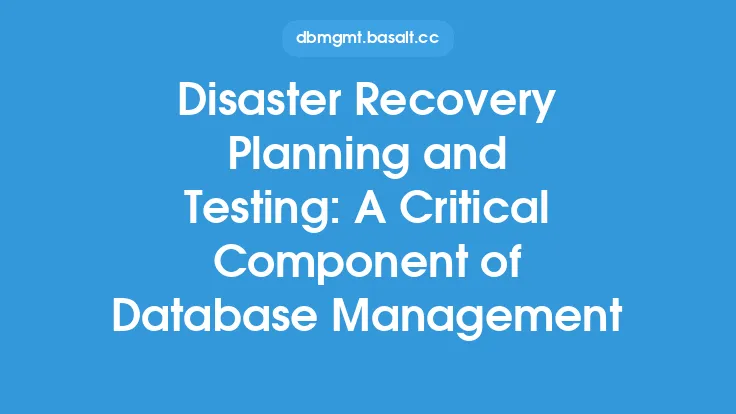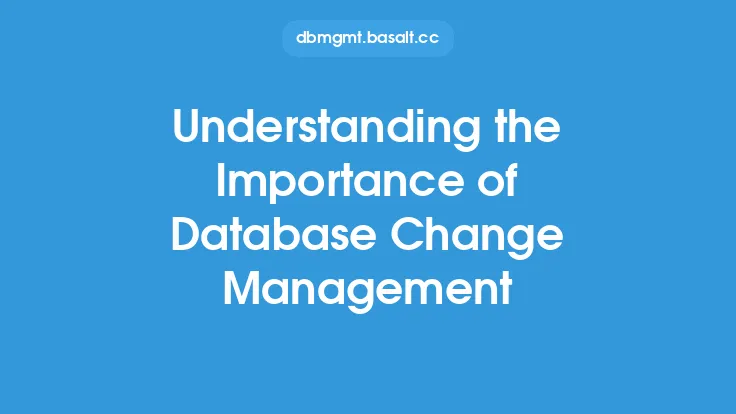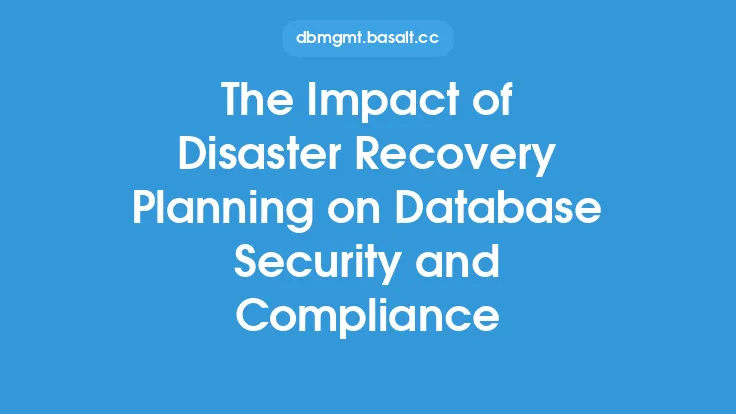Disaster recovery planning is a critical aspect of database management that involves creating and implementing procedures to minimize data loss and ensure business continuity in the event of a disaster. A disaster can be anything from a natural disaster, such as a hurricane or earthquake, to a man-made disaster, such as a cyberattack or hardware failure. The goal of disaster recovery planning is to ensure that the database is restored to a functional state as quickly as possible, with minimal data loss and disruption to business operations.
Introduction to Disaster Recovery Planning
Disaster recovery planning involves identifying the risks and threats to the database, assessing the potential impact of a disaster, and developing strategies to mitigate those risks. This includes creating backup and recovery procedures, establishing a disaster recovery team, and developing a plan for restoring the database and related systems. The plan should also include procedures for testing and maintaining the disaster recovery plan, as well as training personnel on their roles and responsibilities.
Benefits of Disaster Recovery Planning
The benefits of disaster recovery planning are numerous. Firstly, it ensures business continuity by minimizing downtime and data loss. This is critical for organizations that rely heavily on their databases to operate, such as e-commerce companies or financial institutions. Secondly, disaster recovery planning helps to protect the organization's reputation by ensuring that customer data is protected and that business operations are not disrupted. Finally, disaster recovery planning can help to reduce the financial impact of a disaster by minimizing the cost of recovery and reducing the risk of regulatory fines and penalties.
Key Considerations for Disaster Recovery Planning
When developing a disaster recovery plan, there are several key considerations to keep in mind. Firstly, the plan should be tailored to the specific needs of the organization and the database. This includes identifying the critical data and systems that need to be recovered, as well as the resources and personnel required to support the recovery effort. Secondly, the plan should include procedures for backup and recovery, as well as procedures for testing and maintaining the plan. Finally, the plan should be regularly reviewed and updated to ensure that it remains relevant and effective.
Technical Considerations for Disaster Recovery Planning
From a technical perspective, disaster recovery planning involves several key considerations. Firstly, the database should be designed with disaster recovery in mind, including the use of redundant hardware and software components, as well as backup and recovery procedures. Secondly, the database should be regularly backed up, with backups stored in a secure location, such as an offsite data center or cloud storage service. Finally, the database should be designed to support rapid recovery, including the use of techniques such as data replication and log shipping.
Database Backup and Recovery Procedures
Database backup and recovery procedures are a critical component of disaster recovery planning. The goal of these procedures is to ensure that the database can be restored to a functional state as quickly as possible, with minimal data loss. This includes creating regular backups of the database, as well as establishing procedures for recovering the database in the event of a disaster. The procedures should also include steps for verifying the integrity of the backups, as well as testing the recovery procedures to ensure that they are effective.
Disaster Recovery Planning for Different Database Types
Different types of databases require different approaches to disaster recovery planning. For example, relational databases, such as Oracle or MySQL, require a different approach than NoSQL databases, such as MongoDB or Cassandra. Additionally, cloud-based databases, such as Amazon Aurora or Google Cloud SQL, require a different approach than on-premises databases. The disaster recovery plan should be tailored to the specific needs of the database, including the type of database, the size of the database, and the criticality of the data.
Conclusion
In conclusion, disaster recovery planning is a critical aspect of database management that involves creating and implementing procedures to minimize data loss and ensure business continuity in the event of a disaster. The plan should be tailored to the specific needs of the organization and the database, and should include procedures for backup and recovery, as well as procedures for testing and maintaining the plan. By prioritizing disaster recovery planning, organizations can protect their data, ensure business continuity, and reduce the financial impact of a disaster.





